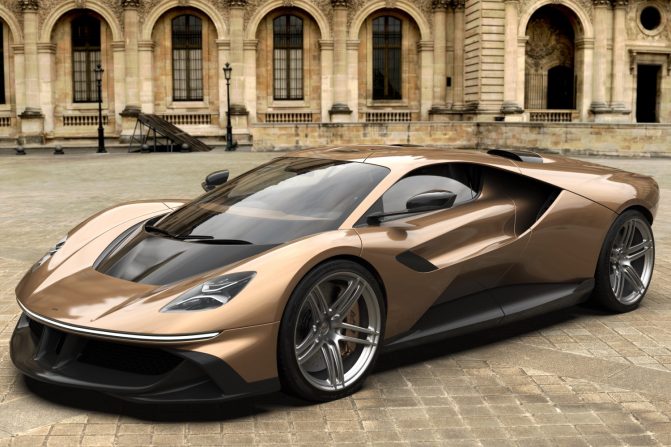In the automotive world, it’s nearly unheard of to connect the ultra-modern “hypercar” segment with the nostalgic, tactile quality of “analogue” driving. Today’s hypercars are typically celebrated for their advanced electronics, a digital arsenal meant to keep their immense power in check and prevent catastrophic mishaps. Their reliance on artificial intelligence and sensor-driven safety systems means the soul of driving—the pure, mechanical feel sought by true motoring enthusiasts—is often lost. But Garagisti & Co., a relatively new and ambitious automaker, is deliberately challenging that narrative with the launch of their latest creation: the GP1 hypercar. According to official statements from the company, the GP1 intentionally avoids electronic driving aids and predictive algorithms, putting the driver in direct control for an unfiltered and invigorating connection with the road.
Rather than pursuing record-breaking lap times or headline-grabbing acceleration figures, Garagisti & Co. has focused on delivering a vehicle that stimulates the senses at every turn. The GP1 is reportedly designed to feel raw, mechanical, and utterly immersive—a concept that resonates locally, especially for many Nigerians who reminisce about the pure joy of driving older cars on winding country roads or through bustling city streets before the era of heavy digital interference. The heart of the GP1 is its spectacular, naturally aspirated 6.6-litre V12 engine, purpose-built by Italtecnica. This Italian-built monster revs to a ferocious 9,000 RPM, delivering a jaw-dropping 800 horsepower and 700 Nm of torque. Even more remarkable, this powerhouse is paired to a 6-speed manual gearbox engineered by Xtrac—offering that all-too-rare, hands-on gear-shifting experience few modern hypercars dare to provide.
A Revival of Analogue Thrills in a Modern World
As the global automotive industry trends toward automatic transmissions and electric powertrains, the traditional manual gearbox—with its three pedals and captivating feel—is fading into obscurity. For Nigerian automotive fans and West African petrolheads alike, the chance to operate a hypercar with a manual transmission is a nostalgic nod to a bygone era, reminiscent of classic Peugeot 504s or Toyota Camrys that lined Lagos roads in the 1980s and 1990s. Of course, taming 800 horsepower and 700 Nm of twist from a high-revving V12 via a manual box demands expertise and full driver attention—a challenging proposition on Nigerian roads famed for their unpredictability. Nonetheless, the purists argue the reward is immense: total engagement and unmatched satisfaction.
One of the most notable engineering feats of the GP1 is its weight. The hypercar reportedly weighs only 1,000 kg (dry), an achievement that puts it among the lightest in its class and gives it a record-worthy power-to-weight ratio of 800 horsepower per tonne. This metric delivers not only fierce straight-line performance but also expert agility and handling—qualities that matter profoundly for drivers navigating anything from Abuja’s wide boulevards to the sharp twists in Calabar or Accra. The question remains: would such a hyper-focused, manual performance machine adapt easily to the realities of African road networks, with their variable surfaces and inconsistent infrastructure?
On the technical side, according to Classic Driver, the GP1 borrows high-performance wisdom from top-tier motorsports. It’s equipped with advanced braking systems from Brembo, robust track-tuned suspension components from Öhlins, and an ultra-rigid carbon monocoque chassis constructed by DEXET. DEXET’s involvement extends to aerodynamic refinement—using principles honed in competitive racing to optimize ground effect and stability at speed. Visually, the car is equally captivating. The design calls back to iconic shapes like the Lamborghini Countach and Lancia Stratos, brands that hold aspirational power across the continent, but with sleek flourishes for a thoroughly contemporary appearance. In Nigeria and Ghana, where automotive styling is a mark of status, the sharp lines and bold presence of the GP1 are bound to turn heads at exclusive events, from Lagos auto shows to private Abuja gatherings.
Every Detail Crafted for Enthusiasts—Inside and Out
Step inside the GP1 and you’re greeted by a cabin deliberately purged of modern digital distractions. There’s no room for flamboyant screens or touch panels; instead, the dashboard is designed with a minimalist, retro-futuristic sensibility. Essential switches and analogue gauges dominate, but the centerpiece remains the custom gear lever—an icon for driving enthusiasts the world over, and particularly for West African drivers who lament the loss of true manual cars from local markets. Upholstery is an exercise in handcrafted luxury, featuring bespoke leatherwork and artisan detailing echoing the custom car scene that’s slowly emerging in Nigeria and Ghana.
However, exclusivity comes at a steep price. As the company has announced, the Garagisti & Co. GP1 starts at approximately £2.45 million (including taxes and shipping). In local terms, this translates to roughly ₦3 billion—well beyond reach for all but the continent’s wealthiest collectors and auto enthusiasts. Its rarity is further underlined by a strictly limited production run of only 25 units worldwide. According to dealership sources in London and Dubai, early orders have already been placed, many by global buyers known for their passion for high-performance vehicles. In West Africa, where high import duties, taxes, and regulatory restrictions apply, even seeing such a car on local roads would be a major event—something akin to spotting a rare work of art.
Still, for those fortunate enough to secure a place in the GP1’s order book, the personalization opportunities are extensive. Each unit is individually commissioned and hand-finished to the buyer’s personal specifications—a hallmark of luxury vehicles and a trend observed among ultra-high-net-worth Africans in recent years. For the first 12 buyers, Garagisti & Co. is offering an immersive “Open Doors” experience, giving access to the creative minds behind the GP1. This includes factory visits and opportunities to engage with engineers and designers—an experience reflecting the growing desire among African collectors to build personal relationships with the brands they support, as seen recently in collaborations with global luxury names from Ferrari to Rolls-Royce.
West African Perspectives: Analogue Power in an Evolving Market
In Nigeria and across much of Africa, the car market is in flux. While the bulk of imports remains affordable sedans, SUVs, and commercial vehicles, there is a steady, albeit small, growth in luxury and performance cars. Lagos-based automotive analyst Chuka Obioha, speaking in March 2024, suggests, “Nigeria’s super-rich are increasingly passionate about cars that make a statement—collectible, rare, and often celebrating traditional engineering over pure digital innovation.” He notes that for most West African motorists, however, the analogue thrills of the GP1 are more aspirational than practical, given harsh realities like road conditions, maintenance challenges, and high insurance costs. Meanwhile, Ghanaian collector Kweku Addo points out that, “cars like the GP1, even if not street-legal here, influence local car culture by inspiring customization trends, and raising the bar for what’s technically possible in African garages.”
Globally, the trend towards electrification, autonomous driving, and connectivity continues at pace. The GP1 stands in vivid contrast, offering a nostalgic breath of fresh air for those seeking the visceral pleasure of hands-on driving. While most Africans might only ever encounter such a car online or at rare international trade shows, the message is clear: the spirit of analogue motoring is alive, carried by a new generation of ultra-exclusive hypercars.
Whether or not the Garagisti & Co. GP1’s formula catches on with African buyers—or sparks similar projects in Nigeria’s growing custom car community—remains to be seen. But it undoubtedly opens discussion: Is there still a place for analogue masterpieces in a digital age, especially within Africa’s unique motoring landscape? Are purist experiences limited to the world’s wealthiest streets, or can they ignite a local renaissance among builders, drivers, and dreamers?
What’s your view: would you embrace a hypercar that puts you, not the computer, in control—even in the challenging driving conditions of Nigeria or Ghana? Can automotive craftsmanship and nostalgia find a new home here? Drop a comment below and join the conversation. For more stories like this, follow us on social media—your insight matters!
Do you have a car story or unique automotive experience to share—or maybe you want to sell your exclusive scoop? We want to hear from you! Reach out at story@nowahalazone.com and your story could be featured or monetized.
Need support or have tips? Email us at support@nowahalazone.com.
Stay connected for the latest automotive updates, reviews, and global tech trends—follow us on Facebook, X (Twitter), and Instagram.
Tell us: Would you dare to drive the GP1, or do you prefer the comfort of advanced electronics? Share your opinion below!









